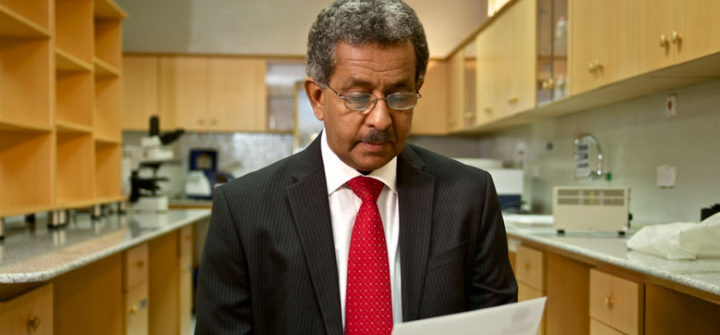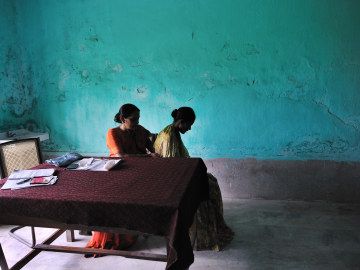One More Chance for a Neglected Disease
On May 21, Dr. Ahmed Fahal will fly anxiously from Khartoum, Sudan to Geneva, Switzerland for the annual World Health Assembly. Twice before, he has left the assembly broken-hearted.
Representatives from 194 countries gather at the WHA every year to hash out top health priorities around the globe. This year, at the 69th meeting, a slight fraction of time will be devoted to an obscure flesh-eating disease called mycetoma, which burdens the poor in two dozen countries near the equator. The disease has been Fahal’s obsession for 30 years.
Caused by either bacteria or fungi that penetrate the skin, mycetoma infections can lead to chronic disability, amputation, and occasionally death. Fahal’s patients travel days to see him from the poorest villages in Sudan, and he’s successfully called attention to their plight. In 1991, Fahal created a clinic devoted to the disease in Sudan’s capital city, where he directs a loyal staff that at times includes scientists and doctors from Europe, Japan, and Australia. In his ongoing campaign, Fahal travels to the WHA in hopes of having mycetoma added to a seminal list of neglected tropical diseases tracked by the WHO. The list more or less dictates the diseases that philanthropists notice.
In anticipation of the Assembly next week, Fahal says, “I am excited because if it is included on the list this year it will open great opportunities for mycetoma patients.” He adds, “I am also worried because any country can say no, don’t include it, and that will be a big blow.”
I first met Fahal at the Assembly last year, in 2015. His broad shoulders slumped forward, and his gaze drifted to the floor as we spoke. He had come to the meeting to convince governments that mycetoma patients deserve their consideration. However, on the first day of the meeting, Fahal learned his disease had not even made the list of items up for discussion. He wasn’t feeling talkative after the news. He said he felt depressed.
Nonetheless, Fahal moved forward on another front, a collaboration with a Geneva-based non-governmental organization called the Drugs for Neglected Disease initiative (DNDi). The group had been testing an antifungal treatment, Fosravuconazole, for a different cause, and they suggested it might fight the fungal form of mycetoma as well. Since then, DNDi moved forward with plans. This summer, they will launch a clinical trial in Sudan led by Fahal, in partnership with the Japanese pharmaceutical company Eisai.
The sheer fact of DNDi’s involvement encouraged Dirk Engels, the head of the WHO’s neglected tropical disease department, to reconsider mycetoma because the organization has proven effective at drug development. Without treatments and diagnostic tests—or at least the prospect of such tools—Engels was hard pressed to convince his colleagues that placing the disease on their list really mattered. After all, the mandate for the WHO is to make concrete recommendations on how to tackle listed diseases—a chore that cannot be empty because it costs time and money. By the end of the WHO executive board meeting in late January, mycetoma was recommended as the 18th neglected tropical disease on the WHO’s list. However, the ultimate decision now relies on government officials attending the Assembly next week.
Engels expects the inclusion of mycetoma, although pushback at the January meeting indicates possible dissent. Specifically, U.S. representatives argued against the addition because they feared it would set a precedent of including any number of maladies willy-nilly. To ease that concern at the WHA, a technical committee was tasked with presenting a systematic process for vetting the addition of diseases to the list. If this process doesn’t satisfy delegates, mycetoma may be passed over again this year.
To Fahal, the “slippery-slope” argument sounds absurd. “It is not fair because these patients deserve attention,” he tells me over the phone. To him, mycetoma is neither abstract nor obscure. He amputates limbs rotted by fungus every few months. He hears desperate tales from patients who sought relief from lousy, expensive medicines, traditional herbs, burning or battery acid—all in vain. “When people come to visit the mycetoma clinic and they see patients, they get so sad,” Fahal says. But, of course, most delegates at the Assembly will not be flying to Khartoum. Instead, Fahal comes to the meeting with photographs on his computer ready for display. They are poorly lit medical images of suppurating sores, swollen stumps, anemic patients. It’s an unpalatable approach, but he’s not sure what else to do.
By the end of next week, Fahal will know what those who set the world’s health agenda decide.
Editor’s Note: Amy Maxmen reported on mycetoma in Sudan for the Global Health NOW series, “The Most Neglected Disease.” Mycetoma was the selected as the Untold Global Health Story of 2015 by GHN and the Consortium of Universities for Global Health.
Join the thousands of subscribers who rely on Global Health NOW summaries and exclusive articles for the latest public health news. Sign up for our free weekday enewsletter, and please share the link with friends and colleagues: Subscribe to GHN





